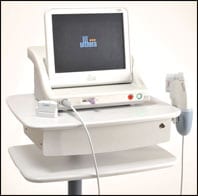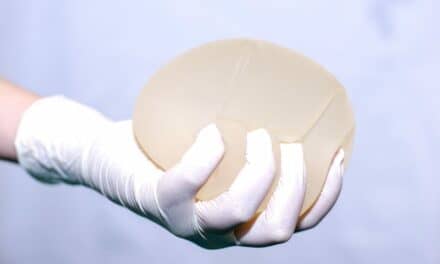 |
In the aesthetic field, the introduction of a truly new technology is cause for celebration, and this year’s US debut of the Ulthera laser-based device qualifies. In September 2009, the FDA granted the Ulthera System a 510(k) “de novo” review.
The system combines visualization beneath the skin’s surface with the delivery of ultrasound energy at depths that enable significant lifting of the skin. Ulthera’s DeepSEE™ technology allows practitioners to see skin tissue—including the dermis, subcutaneous tissue, or deeper—to a depth of up to 8 mm and treat to a desired depth below the surface while not affecting intervening tissue. The imaging system displays precise tissue layers that are targeted for treatment.
“It delivers highly focused acoustic energy, which is selectively absorbed, causing rapid heating inflammation of the discreet thermal coagulation points—on an order of 1 mm QD,” says Neil Sadick, MD, FAAD, FAACS, FACP, FACPh, a dermatologist and researcher based in New York.
The system takes “fractional energy to a completely new level,” Sadick continues, “to know where you are focusing the ultrasound energy at various levels of the skin. Other ultrasound energy systems under investigation are the UltraShape and Liposonics. They are based on somewhat similar approaches but not with discreet disposition of energy at various levels.”
 |
 |
| Female patient before (top) and 90 days after (bottom) treatment. |
“It focuses energy into the skin and produces a small zone of thermal exertation,” says R. Rox Anderson, MD, professor of dermatology at Harvard Medical School. “It heats a small bit of tissue inside the skin without damaging anything else. It is done repeatedly. There is a pattern of those little injuries that occur. That is the mechanism. It basically heats the tissue in a pattern. It is a noninvasive and yet very accurate way of treating the skin.”
“You are able to focus the high amounts of focused energy, which converts into tightening and remodeling of the dermis and deeper tissues,” Sadick says. “You can dial in exactly where the energy is to be delivered by the DeepSEE technology.”
NEGATIVE EFFECTS?
“The negative effects are very minimal,” Anderson says. “It is mildly painful, and you get some swelling and redness after the procedure, which abates in a fairly short amount of time—in a day or 2. People can have this treatment and go about their business. The downtime is minimal. It is not completely free from side effects. It depends on if the device is misused. In competent hands, the side effects are tolerable.”
Compared with laser devices, the Ulthera System has some similarities. “But it does a better job with the tightening,” Anderson says. “If compared to radio frequency—another noninvasive skin-tightening procedure—the Ulthera is more reliably active. There has been a problem with radio frequency devices and knowing who is going to respond. Some patients respond to it, some do not. One of the advantages of the Ulthera is that the response is more predictable. Second, it does not hurt as much. So, you do not have as many issues with the anesthesia.”
|
See also “Liposuction of the Neck” by Michael A. Persky, MD, FACS, in the July 2008 issue of PSP. |
 |
The ideal patient for this treatment comes from any racial background and is middle-aged, according to Anderson. “Where you begin to see some sagging and wrinkling in the face, other than wrinkles of expression,” he says. “Meaning wrinkles due to intrinsic aging, elasticity of the skin, sagging, and redundancy. Those patients benefit the most from [the Ulthera System]. I mean fair-skinned people over the age of about 35, or those who have been exposed to a lot of sunlight if they are not fair-skinned. The fairer your skin type, the more likely you will need this treatment at an earlier age.”
Anderson is very excited about ultrasound as an overall treatment modality. “If you were to make a list of all the forms of energies that we use to treat patients,” he says, “ones that can be focused very precisely deep inside tissue, there are only two things on the list. One is the ultrasound, and the other is x-rays. We are never going to treat people with x-rays for skin problems. The ultrasound is actually unique in its ability to produce well-defined zones of heating deep inside the tissue.”
For the aesthetic practitioner, the technology represented by the Ulthera System is “not just another need-to thing,” Anderson says. The ultrasound technology itself is not brand new—it has been around for several decades. However, as Anderson points out, in the plastic surgery field this is the first time it has been used for this sort of therapy.
“It is actually the beginning of a new type of energy in dermatology and plastic surgery. That is the use of the focused ultrasound with some guidance to it,” he adds.
Shae Waddell, a contributing writer for PSP, can be reached at [email protected].



